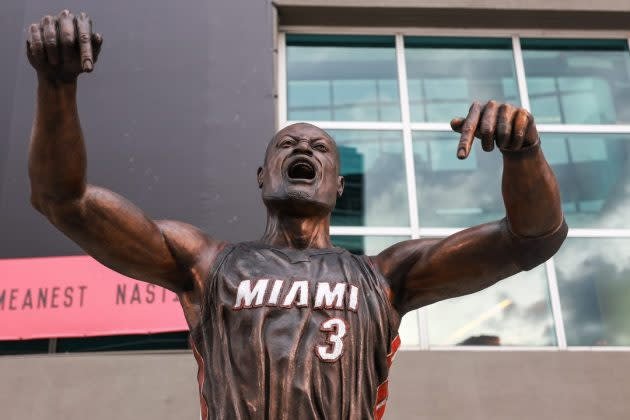Highwood, Ill.—The day after attending the unveiling of the Dwyane Wade statue outside the Kaseya Center in Miami, the artist behind the unintentionally provocative piece, Omri Amrany, was back in his suburban Chicago art gallery, focused on his litany of future projects . .
“I don’t check the comments at all—one of the many things I don’t do—because I keep my brain open for dreams and opportunities and to look forward to,” he told a reporter, standing in the front hallway. of the fine art studio he and his wife, Julie Rotblatt Amrany, have operated in that space since 2005.
More from Sportico.com
A sign on the front door of the red brick building read: “We regret that we cannot invite you in as we are working to sculpt several property projects.”
But on Wednesday afternoon, Amrany agreed to invite sporty into a studio under the condition that none of its projects in progress, which include those of other famous sports figures, would be reported or photographed.
For the previous 48 hours, the Wade sculpture had been subjected to a kind of name, image and likeness debate among sports fans: namely, whether the statue’s expression of open-mouthed supremacy captured the essence of Wade. The verdict, according to the trending hordes on social media—and self-proclaimed art critics like Charles Barkley and Shaquille O’Neal—was that it failed.
On their Inside the NBA show on TNT, Barkley suggested that the statue should be taken down and redone. Shaq dismissed it as the “scariest thing this Halloween,” seemingly unaware that he was insulting the work of a man who had previously memorialized him in bronze.
The object of their ridicule was designed to capture Wade’s demonstrative reaction to hitting a game-winning 3-pointer at the buzzer for the Miami Heat in a 2009 home win against the Chicago Bulls, his hometown team. After taking the shot, Wade jumped onto a side scoreboard of what was then called American Airlines Arena, yelling “this is my house” to an adoring crowd. Wade, who retired from basketball in 2019, called this his “favorite individual moment of my career.”
For his part, Wade rallied to the statue’s defense, saying it lived up to its vision.
“The commission (of art) is a triangle between the client, the subject and the artist,” said Amrany, who worked on the project alongside Oscar Leon, one of seven artists who work out of the Rotblatt Amrany studios. “And the end result of this triangle will probably stand on a pedestal to be reviewed by the rest of the world.”
This is what Amrany hopes the world will finally understand: the purpose of the sculpture was not meant to be a product of portrait realism, but to capture the essence and story behind the subject. The sculptor insists that he has no problem with criticism of his work, but thinks that his recent detractors have not gasped for that distinction.
“They’re missing the whole story of a kid who had nothing who became everything, and that was his expression when he jumped on the table and told his hometown team, ‘This is my house,'” Amrany said. “This is a wonderful American story that they’re missing because what they want is a very boring face. And I’m sorry, they’re not going to get it from me.”
Wade’s sculpture was unveiled nearly 30 years to the date of Amrany and his wife’s most famous sports creation, the Michael Jordan statue at the United Center. Known as “The Spirit”, the figure of mid-flight MJ helped launch the sports cast metal subgenre and became the calling card of the studio Rotblatt Amrany. Amrany said the Bulls paid $250,000 for the commission, but he did not say how much the Heat paid for Wade.
In the three decades since conjuring The Spirit, the Rotblatt Amrany studio has produced bronze statues to celebrate the achievements of Kobe Bryant, Barry Sanders, Dirk Nowitzki, Bob Cousy, David Beckham, Elgin Baylor, Wilt Chamberlain, Bobby Hull, Vince Lombardi and the previously mentioned Shaq, among many other famous athletes and coaches. In total, the studio has done more than 300 projects around the world, from individual busts to municipal parks.
But as Amrany recalled, when the Jordanian statute was publicly unveiled at a press conference on November 1, 1994, it was not widely greeted with praise. Rather, there were some initial complaints from the public and media about the way it portrayed Jordan’s face, including the decision to keep the Hall of Famer’s famously wagging tongue hidden behind his lips.
“They didn’t like that his face wasn’t directly at a cereal box,” Amrany said. “They didn’t want what (Jordan) said he wanted. And they didn’t know that, because they didn’t meet him, they didn’t sit with him.
Fortunately, that experience long predated the age of social media and the current “world of algorithms,” as Amrany puts it. The peanut gallery is infinitely more critical and fickle in 2024.
“I mean, after 20 articles (about Wade’s sculpture) in the last three days,” Amrany said, “what you become is not famous, but infamous.”
Although discouraged, he said he took note of the experience for future reference.
“Maybe even next time I would suggest to the (subject) that they be aware of what (reaction) you’re going to get,” Amrany said.
Best of Sportico.com
Sign up for Sportico newsletter. For the latest news, follow us on Facebook, Twitterand Instagram.
